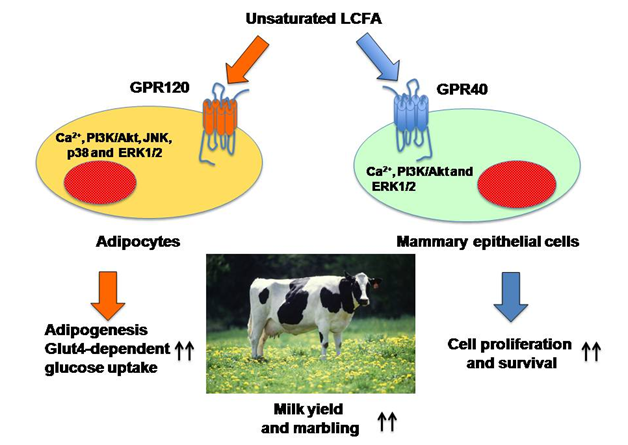Advances in
eISSN: 2373-6402


G Protein-Coupled Receptor (GPCR) super family represents the largest protein family in the human genome. These receptors respond to various physiological ligands such as photons, odors, pheromones, hormones, ions, and small molecules including amines, amino acids to large peptides and steroids. GPCRs are involved in many biological responses and the target of around half of all conventional drugs. The physiological roles of Free Fatty Acids (FFAs), in particular, long-chain FFAs, are important for the development of many metabolic diseases including obesity, diabetes, and atherosclerosis. In the past half decade, deorphanization of several GPCRs has revealed that GPR40 and GPR120 sense the concentration of extracellular fatty acids. GPR40 and GPR120 are activated by long-chain FFAs. GPR40 is expressed in mammary epithelial cells and lactating mammary glands, and possesses strong proliferative and survival effects via an activation with unsaturated long-chain fatty acid. GPR120 is expressed in adipocytes and adipose tissues and plays an important role for FFAs-induced glucagon-like peptide-1. The objective of this review is to explore whether or not it is possible to enhance the yield of dairy milk and the quantity of fat marbling in beef by supplementing unsaturated The objective of this review is to explore whether or not it is possible to enhance the yield of dairy milk and the quantity of fat marbling in beef by supplementing unsaturated FFAs with lactating mammary glands.
Keywords: GPR40, GPR120, unsaturated long-chain fatty acids, lactating mammary glands, marbling
GPCRs, G protein-coupled receptors; LCFAs, long-chain fatty acids; GLP-1, glucagon-like peptide-1; ERK, extracellular regulated kinase; JNK, cJun N-terminal kinases; PI3K, phosphatidylinositol-3kinase; PTX, pertussis toxin; PUFA, poly unsaturated fatty acid; Glut, glucose transporter
We are writing this review, November 8, on whether or not it is possible to enhance the yield of dairy milk and the quantity of fat marbling in beef by supplementing unsaturated FFAs with lactating mammary glands. We’ve examined the effects of fatty acids on mammary epithelial cells and adipocytes including cow.1-3 The ligands of two G Protein-Coupled Receptors (GPCRs), were recently identified as Long-Chain Fatty Acids (LCFAs) in the blood.4-6 One is GPR40, which three different groups pointed out as being highly expressed in pancreatic islets, and particularly in pancreatic beta-cells secreting insulin.3-5 Another is GPR120.7 This is exclusively expressed in the intestines, especially enteroendocrine cells, L-cells producing Glucagon-like Peptide-1 (GLP-1).6 GPR120 couples Gq/11 proteins and activates extracellular regulated kinase (ERK) 1/2, cJun N-terminal kinases (JNK), p38 and Phosphatidylinositol-3Kinase (PI3K)/Akt signaling pathway8 (Figure 1 left portion). Both GPCRs play an essential role in LCFAs-induced secretion of each hormone. It is critical to understand how LCFAs affect cells and tissues through GPCRs.

Additionally, concurring with another group we and another group demonstrated that GPR40 functions in cell proliferation and survival through ERK 1/2 and PI3K/Akt signaling pathway 1,2,9,10 and its coupling manner to G protein is mainly dependent on Gi/o, which is Pertussis Toxin (PTX)-sensitive, and to lesser extent Gq/11 1,7 (Figure 1 right portion). It is striking that unsaturated LCFA, but not saturated, possesses strong proliferative and survival effects on mammary epithelial cells, including bovine mammary epithelial cells.1,7 This could potentially have an effect on the inhibition of apoptosis in lactating mammary glands, resulting in enhancement of the duration of lactation, the yield of milk production, and the quality of milk fat (Figure 1).
In adipose tissue, Roh’s group demonstrated that GPR120, but not GPR40, is exclusively expressed and its expression is induced through adipogenesis.3 Furthermore, they also demonstrated that specific knocked-down GPR120 inhibits adipogenesis, indicating GPR120 plays an important role in adipogenesis and fat accumulations.3 Indeed, in human and mouse studies, Poly Unsaturated Fatty Acid (PUFA) stimulates the Glucose Transporter (Glut) 4-dependent glucose uptake through GPR120, which is de novo lipid synthesis and anabolism.11 Taken together, intramuscular or intravenous infusion with LCFAs, especially if unsaturated, may contribute to the development of marbling in cows.
Finally, we emphasize that the supplementation of milk and beef with LCFAs may potentially enhance milk yield and the quality and composition of marbling.
The authors sincerely thank Mr. Stephen Stratton for his contribution in the preparation of this manuscript. This work was supported by a Grant-in-Aid for Young Scientists (B) from Japan Society for Promotion of Science (JSPS-25830062).
The author declares no conflict of interest.

© . This is an open access article distributed under the terms of the, which permits unrestricted use, distribution, and build upon your work non-commercially.